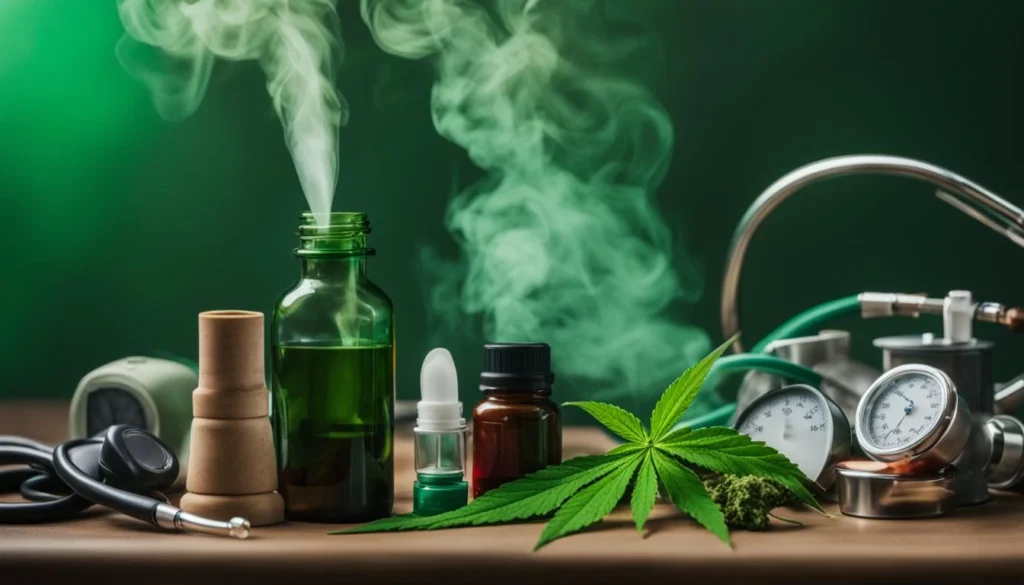If you’re seeking alternative treatment options for rehabilitation, medical cannabis may be a viable option worth considering. Medical cannabis has been linked to potential health benefits, including pain relief, reducing inflammation, and improving sleep quality.
Unlike recreational marijuana, medical cannabis is used under a doctor’s supervision and offers a safe, effective, and natural way to treat a range of conditions. In particular, it has been proven to help with rehabilitation purposes.

Key Takeaways
- Medical cannabis is a potential alternative treatment option for rehabilitation purposes.
- It offers various health benefits and can be used under a doctor’s supervision.
- Unlike recreational marijuana, medical cannabis can provide safe and effective treatment for managing symptoms and conditions.
Understanding Medical Cannabis and Its Benefits
If you’re considering using medical cannabis for rehabilitation purposes, it’s important to understand what it is and how it works in the body. Medical cannabis refers to the use of the cannabis plant or its chemical components, such as Cannabidiol (CBD) and Tetrahydrocannabinol (THC), as a form of treatment for various medical conditions.
The cannabis plant contains over 100 chemical compounds known as cannabinoids. THC is the primary psychoactive compound responsible for the “high” associated with cannabis use, while CBD is non-psychoactive and believed to have therapeutic effects. Medical cannabis is available in various forms, including dried leaves, oils, capsules, and edibles.
The potential benefits of using medical cannabis for rehabilitation purposes include:
- Reduced inflammation and pain relief
- Improved sleep and relaxation
- Reduced nausea and vomiting
- Improved appetite
- Improved mood and reduced anxiety
Studies have shown that medical cannabis may be effective in treating chronic pain, multiple sclerosis, epilepsy, and post-traumatic stress disorder (PTSD), among other conditions. However, more research is needed to fully understand its potential benefits and risks.
It’s important to note that medical cannabis is not a cure-all and should not be used as a substitute for traditional medical treatment. Consult with your healthcare provider to determine if medical cannabis is a suitable treatment option for your specific condition and to discuss dosage and administration.
The role of medical cannabis in marijuana therapy
Marijuana therapy, otherwise known as medical marijuana for therapy, is the use of marijuana or its components to treat medical conditions. Medical cannabis is a vital component of marijuana therapy and has been shown to play a crucial role in the treatment of various conditions.
Understanding marijuana therapy
Marijuana therapy involves the use of cannabis for medical purposes. The cannabis plant contains various chemicals known as cannabinoids that interact with the body’s endocannabinoid system, which regulates various physiological processes. Medical cannabis is used to treat various medical conditions, including chronic pain, nausea, muscle spasms, and anxiety.
Medical cannabis benefits in marijuana therapy
Medical cannabis offers various benefits in marijuana therapy. Its primary benefits include pain relief, reduction of inflammation, muscle relaxation, and anti-anxiety effects. Medical cannabis has also been used to manage symptoms associated with conditions such as multiple sclerosis, Crohn’s disease, and epilepsy.
Conditions that can benefit from marijuana therapy
Marijuana therapy can be used to treat several medical conditions. These include chronic pain, conditions that cause muscle spasms, nausea and vomiting associated with chemotherapy, and other conditions that result in a loss of appetite. Medical cannabis has also been used to treat symptoms associated with mental health conditions such as anxiety and depression.
Medical cannabis as part of a comprehensive treatment plan
Medical cannabis is often used in conjunction with other treatments as part of a comprehensive treatment plan. Combining medical cannabis with other therapies such as physical therapy and counseling can help patients achieve the best possible outcomes.

Medical cannabis offers a promising treatment option for patients with various medical conditions as part of marijuana therapy. Its benefits include pain relief, muscle relaxation, and anti-anxiety effects. When combined with other therapies, medical cannabis can be an effective tool for improving patients’ outcomes.
Cannabis treatment options for rehabilitation
There are various cannabis treatment options available for those seeking rehabilitation. It is important to note that the right treatment option will vary depending on the individual and their specific needs. Consulting with a healthcare professional experienced in medical cannabis is crucial.
Vaporizing
One method of cannabis consumption is vaporizing. This involves heating the cannabis to a temperature that releases active compounds without burning the plant material. Vaporizing is a popular method as it allows for precise dosages, fast-acting effects, and avoids the potential harm of smoking.
Tinctures and oils
Tinctures and oils are another option for cannabis consumption. They involve adding a few drops of the cannabis extract to food or drink, making it a discreet option. The effects of tinctures and oils can be longer-lasting than vaporizing, making them ideal for managing symptoms throughout the day.
Edibles
Edibles are a popular form of cannabis consumption, with various food and drink options available. However, it is important to note that edibles have a delayed onset time, and it can take up to an hour or more to feel the effects. Careful dosage control is essential when consuming edibles.
Topicals
Topical cannabis products can be applied directly to the skin and are commonly used for localized pain relief. They do not produce psychoactive effects and can be helpful for managing symptoms associated with physical rehabilitation.
When it comes to cannabis treatment options for rehabilitation, it is important to consider factors such as dosage, consumption method, and potential side effects. Consulting with a healthcare professional is crucial in determining the right treatment plan for you.
How Medical Cannabis Enhances the Recovery Process
Using cannabis for recovery purposes can have a powerful impact on overall rehabilitation. Medical cannabis has numerous benefits that can enhance the recovery process, including pain relief, reduction of inflammation, improved sleep, and management of symptoms associated with rehabilitation.
In fact, medical cannabis has been shown to be a promising treatment option for chronic pain, which is often a primary concern for individuals undergoing rehabilitation. Medical cannabis can be used as an alternative to traditional pain medications, which can have harmful side effects and lead to addiction.

Additionally, medical cannabis has anti-inflammatory properties that can help reduce swelling and inflammation in the body. This can be especially beneficial for individuals recovering from injuries or surgeries, as it can aid in the healing process and promote overall wellness.
Improving sleep is also a critical component of the recovery process, as it allows the body to rest and repair itself. Medical cannabis has been shown to improve sleep quality and duration, making it an effective tool for individuals undergoing rehabilitation.
Finally, medical cannabis can help manage symptoms associated with rehabilitation, such as nausea, loss of appetite, and anxiety. By alleviating these symptoms, individuals can better focus on their recovery and overall well-being.
In conclusion,
Using medical cannabis for rehabilitation purposes can provide numerous benefits that enhance the recovery process. From pain relief to improved sleep and symptom management, medical cannabis is a promising alternative treatment option. As always, it is important to consult with healthcare professionals and integrate medical cannabis into a personalized rehabilitation treatment routine.
Integrating medical cannabis into your treatment routine
If you’re considering using medical cannabis for rehabilitation purposes, it’s important to start by consulting with healthcare professionals. They can offer personalized advice on how to integrate cannabis into your treatment routine.
When it comes to dosage considerations, it’s important to start low and go slow. This means starting with a small dose and gradually increasing it as needed. Be sure to keep track of how you feel and adjust the dosage accordingly.
There are various consumption methods available for medical cannabis, including smoking, vaporizing, edibles, and tinctures. Each method has its own unique benefits and potential side effects, so it’s important to discuss your options with your healthcare provider.
In addition to consulting with healthcare professionals, it’s important to educate yourself on the potential benefits and risks of using medical cannabis for rehabilitation purposes. Research studies have suggested that it can help alleviate pain, reduce inflammation, improve sleep, and manage symptoms associated with rehabilitation.
By integrating medical cannabis into your treatment routine, you may be able to enhance the overall effectiveness of your rehabilitation journey.
Exploring the Legal Aspects of Medical Cannabis for Rehabilitation
Before considering medical cannabis for therapy, it’s important to understand the legal aspects surrounding its use. While medical marijuana is legal in some states, it remains illegal on a federal level. This creates a complex legal landscape that can be difficult to navigate.
It’s crucial to familiarize yourself with the laws in your state regarding medical cannabis. Some states have specific regulations on the possession, use, and cultivation of cannabis for medical purposes. In other states, medical cannabis may only be available through licensed dispensaries.
It’s important to note that even in states where medical cannabis is legal, there may be restrictions on who can access it. In some cases, only patients with certain medical conditions may be eligible for medical cannabis. Additionally, healthcare providers may need to provide certification or documentation to confirm a patient’s eligibility.
While the legal landscape surrounding medical cannabis can be challenging, it’s important to remember that many patients have found relief through this alternative therapy. If you’re considering medical cannabis for rehabilitation, be sure to consult with healthcare professionals and adhere to the laws in your state.
Real-life success stories: Medical cannabis for rehabilitation
Using medical cannabis for rehabilitation purposes has transformed the lives of many individuals struggling with various health conditions. Here are some inspiring real-life success stories that highlight the benefits of using medical cannabis.
Case study 1: John’s journey to recovery
John had been struggling with chronic pain due to a severe accident that left him with multiple fractures. Despite undergoing several surgeries and trying various medications, he found little relief.
After consulting with his healthcare provider, John decided to try medical cannabis as a form of pain management. He started with low doses and gradually increased his dosage under the guidance of his provider. Soon after, he noticed a significant improvement in his pain levels and was able to reduce his dependence on other medications.
Today, John reports feeling more comfortable and mobile, and he attributes his progress to incorporating medical cannabis into his treatment routine.
Case study 2: Sarah’s journey to wellness
Sarah had been living with anxiety and depression for years, and her condition had taken a toll on her overall well-being. She had tried various medications and therapies, but nothing seemed to work.
After researching alternative treatment options, Sarah decided to try medical cannabis. She found that it helped her feel more relaxed and calm, and it also helped her manage her symptoms of anxiety and depression.
Now, Sarah reports feeling more in control of her mental health and better able to manage her daily tasks. She feels that medical cannabis has given her a new lease on life, and she’s grateful for the positive impact it’s had on her well-being.
Case study 3: Tom’s journey to pain relief
Tom had been struggling with chronic pain due to a degenerative condition that affected his joints. He had tried various pain medications, but found that they often left him feeling foggy and unable to carry out his daily activities.
After conducting extensive research, Tom decided to try medical cannabis as a form of pain relief. He found that it helped alleviate his pain without the negative side effects he experienced with other medications.
Today, Tom reports feeling more energized and focused, and he’s able to carry out his daily activities with more ease. He credits medical cannabis for allowing him to manage his pain levels and maintain his overall quality of life.
These real-life success stories demonstrate the potential benefits of using medical cannabis for rehabilitation purposes. However, it’s important to note that medical cannabis should be used under the guidance of a healthcare provider. Consult with a professional to determine if medical cannabis is right for you and to receive personalized advice on dosage and administration.
Conclusion
Medical cannabis is a promising alternative treatment option for those undergoing rehabilitation. By understanding its potential benefits and its role in marijuana therapy, individuals can explore different cannabis treatment options to enhance their recovery process. Integrating medical cannabis into your treatment routine can be done with the guidance of healthcare professionals, and it has the potential to alleviate pain, reduce inflammation, improve sleep, and manage symptoms associated with rehabilitation.
It is important to note that the legal aspects surrounding the use of medical cannabis for rehabilitation vary across different states in the United States. However, real-life success stories have shown the positive impact medical cannabis can have on the recovery journey.
If you are interested in using medical cannabis for rehabilitation purposes, consult with healthcare professionals for personalized advice. They can provide guidance on dosage and administration, ensuring the safe and effective use of medical cannabis. Consider this alternative treatment option and explore the potential benefits it may have for your journey towards recovery.
FAQ
Q: Can medical cannabis be used for rehabilitation purposes?
A: Yes, medical cannabis can be used as an alternative treatment option for rehabilitation purposes. It has shown potential benefits in promoting recovery and managing symptoms associated with rehabilitation.
Q: What are the benefits of using medical cannabis for rehabilitation?
A: Medical cannabis has been found to alleviate pain, reduce inflammation, improve sleep, and manage symptoms associated with rehabilitation. It can enhance the recovery process and provide relief from various conditions.
Q: What is marijuana therapy and how does medical cannabis play a role in it?
A: Marijuana therapy involves using medical cannabis as a form of treatment for rehabilitation. Medical cannabis can be integrated into a treatment routine to help manage pain, reduce inflammation, and support overall recovery.
Q: What are the different cannabis treatment options available for rehabilitation?
A: There are various cannabis treatment options for rehabilitation, including oral consumption, inhalation, topical application, and sublingual administration. It is important to consult with healthcare professionals to determine the most suitable option for individual needs.
Q: How does medical cannabis enhance the recovery process?
A: Medical cannabis enhances the recovery process by providing pain relief, reducing inflammation, improving sleep quality, and managing symptoms associated with rehabilitation. It can contribute to overall well-being during the recovery journey.
Q: How can I integrate medical cannabis into my rehabilitation treatment routine?
A: To integrate medical cannabis into your rehabilitation treatment routine, it is important to consult with healthcare professionals who have expertise in medical cannabis. They can provide guidance on dosage, administration methods, and potential interactions with other medications.
Q: What are the legal aspects of using medical cannabis for rehabilitation?
A: The legal aspects of using medical cannabis for rehabilitation vary across different states in the United States. It is important to familiarize yourself with the specific regulations and consult with legal experts to ensure compliance with the law.
Q: Are there any real-life success stories of using medical cannabis for rehabilitation?
A: Yes, there are many real-life success stories of individuals who have used medical cannabis for rehabilitation purposes. These stories highlight the positive impact medical cannabis had on their recovery journey and overall well-being.
Q: Should I consider using medical cannabis for rehabilitation purposes?
A: Considering medical cannabis as a treatment option for rehabilitation purposes is a personal decision. It is recommended to consult with healthcare professionals to discuss individual needs, potential benefits, and any potential risks or concerns.



